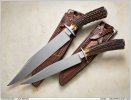- Joined
- Jan 17, 2008
- Messages
- 539
Recently I've been forging a lot of smallish knives (blade length 1.5"-3") from round bar. Mostly for carving and general utility blades. I've been using O1, as it's cheap, easy to get, forges well, and performs just fine.
I was just on Amazon and saw that they are selling 52100 round bar for quite a reasonable price. 0.29" diameter (which is more than enough for my needs) and six feet long for about $16 shipped Prime (Which in Alaska is worth more than the item is). That's an increase of maybe 10% over the O1 I've been using. What do you think for cost vs. performance? Is 52100 10% more steel than 01?
I was just on Amazon and saw that they are selling 52100 round bar for quite a reasonable price. 0.29" diameter (which is more than enough for my needs) and six feet long for about $16 shipped Prime (Which in Alaska is worth more than the item is). That's an increase of maybe 10% over the O1 I've been using. What do you think for cost vs. performance? Is 52100 10% more steel than 01?


